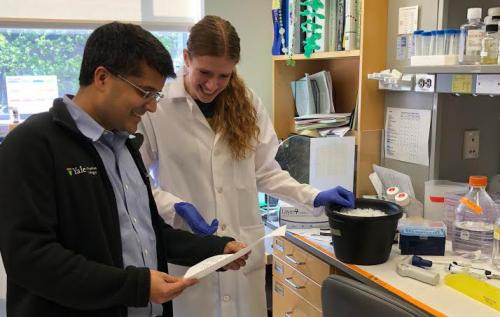
As a doctor treating brain tumors, as an entrepreneur launching life sciences ventures, and as a scientist running clinical trials – Ranjit Bindra, MD, PhD, Associate Professor of Therapeutic Radiology and Experimental Pathology at the Yale School of Medicine, spends his career asking and answering questions. His most recent inquiry was whether the molecular structure of a previously FDA-approved drug for high blood pressure, mibefradil, could be re-purposed to treat patients with incurable brain tumors. The Bindra laboratory was the first to report that in addition to reducing blood pressure, mibefradil also inhibits DNA repair, a key process important for tumor survival after treatment with radiation therapy and chemotherapy.
Bindra explains, “We assume that a drug is used to treat one disease, and only one disease. This isn’t often the case.” In this instance, there was something about the molecule – separate from its blood pressure function – that showed promise in the fight against brain tumors. Bindra’s first clinical trial demonstrated that the drug could be given at high doses in patients with recurrent brain tumors, and they observed intriguing signals of activity suggesting it could improve survival in these patients. In parallel, while working in his laboratory and with the Yale Center for Molecular Discovery, he and his team realized that the anti-tumor effects of the drug could be separated from its effects on lowering blood pressure. Specifically, they found a better version of the molecule that could still block DNA repair to work against brain tumors, but that would not put brain tumor patients at risk for lowering their blood pressure unnecessarily.
According to Bindra, “We realized we could make a new and better version of the therapeutic, but my laboratory could not do it alone.” That is where PITCH came into the picture. The PITCH chemistry and biology team made 150 derivatives of the key molecule. They steadily worked to get rid of liabilities and, over two years, they made a better molecule that has enhanced the ability to block DNA repair and sensitize brain tumors to the effects of radiation treatment.
In brain tumors such as glioblastoma or gliomas, tumors recur at the site where it was first found. There is keen Interest in medicines that can be combined with surgery, chemotherapy and radiation and enhance local tumor control. Bindra hopes that his work with PITCH is the first step in the drug creation process to solve for this need.
Bindra is looking forward to the next step, and knows that the two years of work that the PITCH team put into the project was essential. PITCH, according to Bindra, is, “the critical bridge for ideas that need a little bit of incubation and are at the interface of academia and a full-fledged venture. From a venture capital perspective, PITCH de-risks projects, and for initial founders, PITCH helps us sound-check our ideas before we go on the road.”
* Photo by Aravind Nambiar Kalathil
